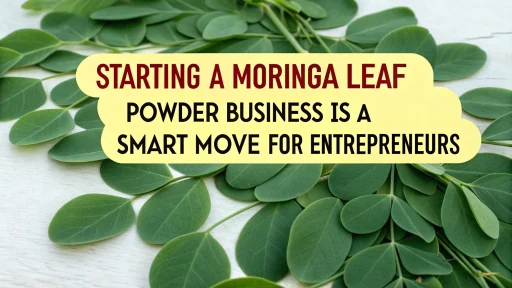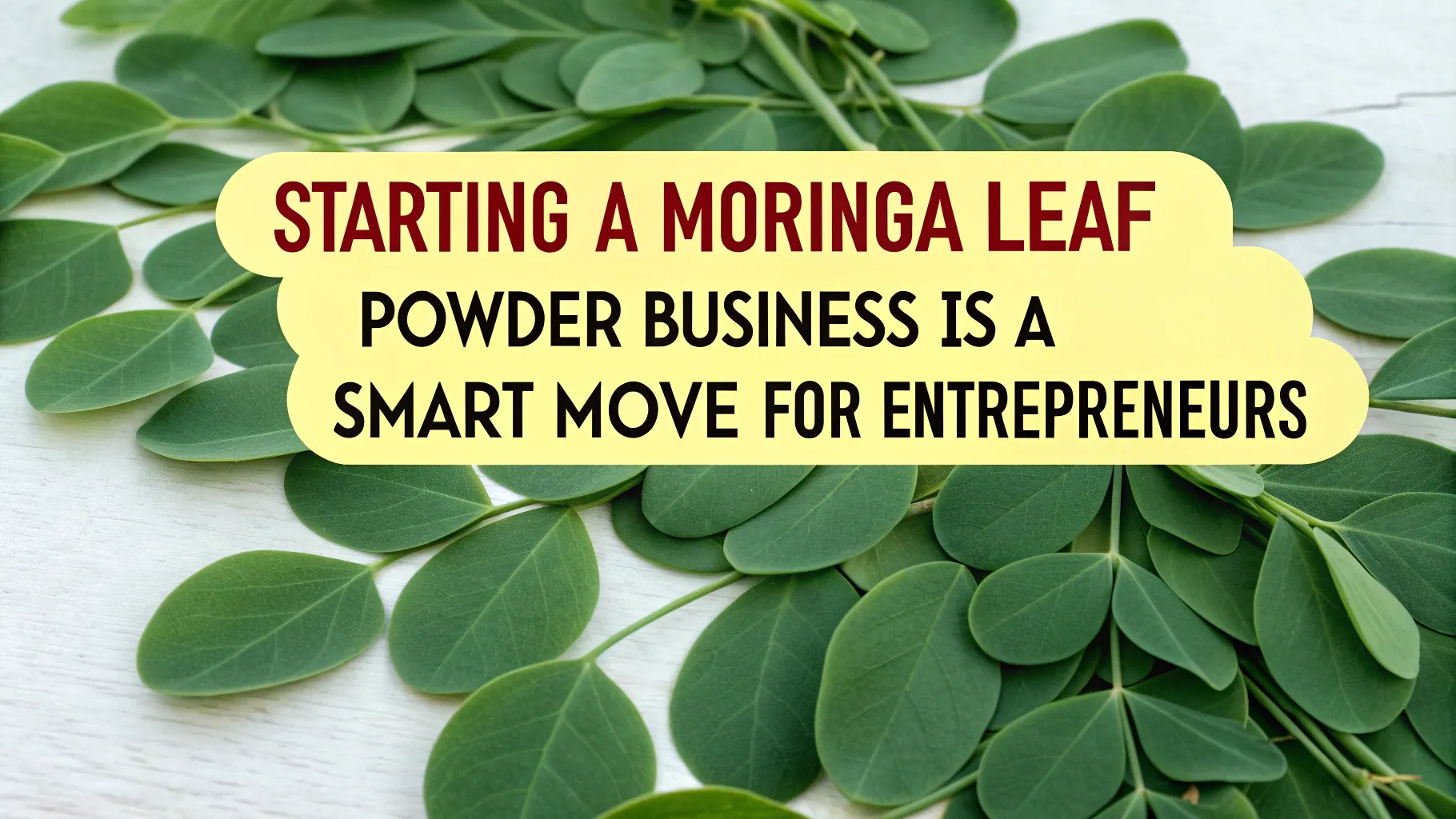Moringa, a Superfood Opportunity
The global trend towards organic living, plant nutrition, and eco-friendly practices in recent years has led to a revival of many ancient crops. The “Miracle Tree” is one of the most important. This hardy plant, native to the Indian Subcontinent, offers a variety of commercially valuable products, from seed oil to biofertilizer, but it’s the powdered leaf that has captured the imaginations and interest of health-food entrepreneurs.
Moringa processing and cultivation, once the domain of backyard gardens, now support a rapidly growing international trade network. Moringa Leaf Powder Business makes a great choice for agripreneurs looking to invest in a high-profit venture.
Why Moringa Leaf Powder Commands Premium Value
Moringa’s allure lies in its adaptability. It can thrive in semi-arid areas with minimal inputs and yield high returns in regions where other cash crops have failed. Once coppiced a single trunk regenerates leaves continuously over several years. This allows harvests to be made every three or four months. These leaves provide a nutritional powerhouse: more than 90 micronutrients and over 40 antioxidant compounds, as well as a complete complement of essential amino acids. After being harvested at dawn, it is shade-dried to preserve the delicate phytonutrients and enzymes. It is then milled under strict hygiene standards. The resultant fine, emerald green powder, can sell for more than INR 2,000 a kilogram.
Moringa Leaf Powder has been adopted by diverse industries, despite its low cost. It is used by nutraceutical companies to boost immunity, by functional beverage manufacturers in juices and smoothies. Cosmetic brands use it as a face mask and lotion for its purported skin-regenerating qualities. Moringa is being used in animal feed as a source of protein for aquaculture and livestock.
Related: Profitable Moringa Leaf Powder Business Opportunities
Global Market Dynamics
The global Moringa Market is expected to grow at a rate of approximately 6-7 percent between 2024 and 2028. It will go from USD 0.62 billion in 2024, up to USD 1.03 billion by 2033. In North America and Europe, the demand is driven by health-conscious Gen Z and millennial consumers who value plant-based superfoods. In Southeast Asia, an emerging middle class is looking for traditional herbal remedies that are backed up by modern science.
Awareness campaigns by state governments in India and Ayurveda Councils have accelerated the domestic consumption. Tamil Nadu, Maharashtra, and Andhra Pradesh are the top three states in terms of acreage. They will collectively plant over 70,000 ha in 2023-24.
In 2024, exports of Moringa leaf powder will reach nearly USD 9,000,000, mainly to the United States, the United Kingdom, and Canada. These shipments are often certified organic, which means they command higher prices. As e-commerce platforms offer a wider range of Moringa-infused beauty serums, teas, and snack bars, domestic retail volumes also increase.

Market Entry Strategies
To enter the Moringa Leaf Powder market, you need more than just saplings. You also need a strategy for positioning yourself and going to market. Entrepreneurs must first identify their target market.
Do you sell to health food stores that charge a premium price? Are you aiming for nutraceutical producers to buy in bulk? Will you tap into the rapidly growing direct-to-consumer (D2C), selling sachets via your website and social media storefronts, or will you stick to the traditional D2C channel? Each route has its own requirements for product quality, packaging, certification, and marketing budget.
Distribution partnerships are also crucial. Working with established organic-food distribution companies or wellness chains can increase shelf presence, but also reduce margins. If you can invest in content marketing and influencer collaborations, you can also maintain pricing control by carving out your niche on digital markets. Subscription models, such as sending monthly sachet bundles, have been used by many successful new entrants to build predictable revenue streams.
Value Added Product Lines
While pure Moringa Leaf powder is the core product, downstream diversification can increase revenue. Moringa-fortified blends of tea are a popular innovation. Leaves are blended with green tea or herbs like tulsi to create new flavor profiles. Moringa powders that combine it with bananas, spirulina, or beetroot have gained popularity among consumers who are fitness-oriented. Moringa is a good candidate for cosmetics, as its high oleic acids are ideal in hair masks and face cleansers that promote anti-aging effects.
Animal-nutrition companies have started trials of Moringa Leaf Powder to increase protein intake for poultry and aquaculture. Moringa is also touted by organic farmers as a potential botanical pesticide when extracted and sprayed onto pest-prone plants. Each extension requires its own quality control protocols, packaging formats, and regulatory clearances. However, cumulatively, they can double or even triple the average order value of a processor.
Related: Moringa Powder Business Success Blueprint: From Startup to Superfood Empire
Social Impact and Sustainability
Moringa farming accords well with sustainable agriculture principles. Its low fertilizer requirements and drought resistance help reduce environmental stress, while its nitrogen-fixing qualities help restore degraded soils.
Smallholders and women’s Self-Help Groups can work together to process leaves. This promotes rural livelihoods and the inclusion of gender. Many NGOs and CSR arms of corporations have funded village-level shade drying units and solar-powered grinding mills to ensure that value-adding and profits remain local.
Exporters are now providing “farm-to-pack” traceability. Each batch is tagged with GPS and photographed during every stage of processing. Although still in their infancy, blockchain pilots promise greater transparency. Solar energy, rainwater collection and zero-waste packaging can be used to demonstrate a low-carbon footprint. This will unlock premium contracts from eco-sensitive brands overseas.
Government Schemes and Financing Options
A small-scale Moringa processor, which includes a nursery and shade-drying facility as well as a grinder, costs typically between INR 5 lakhs and INR 10 lakhs. Entrepreneurs have multiple funding options: Priority-sector loan programs at sub-subsidized rates of interest, microfinance for SHGs or equity financing from impact investors interested in agritech. Micro-enterprises can secure loans of up to INR 50 lakh under the Pradhan Mantri MUDRA Yojana. Repayment terms are tailored to suit cash-flow cycles.
Assam, Himachal Pradesh Gujarat provide additional incentives, including capital subsidies to set up processing units and training grants. They also offer export promotion assistance. The National Horticulture Board regularly publishes requests for proposals as part of its Mission for Integrated Development of Horticulture. This includes Moringa in its portfolio of high-value crops. These schemes can be applied on time to reduce the upfront costs of 20-30%.
Quality Assurance and Compliance
Regulator mistakes can ruin a reputation in the health supplement industry. To prevent microbial development, producers must keep moisture levels below 8 percent. They also need to ensure that the powder is fine enough (typically 80 mesh) for consumers. Regular pesticide residue analysis and heavy metal testing are essential to prevent contamination, particularly for exports. Registration with the Food Safety and Standards Authority of India is required, and organic certification by USDA Organic or EU Organic bodies can open doors to premium markets.
Implementing Good Manufacturing Practices and Hazard Analysis Critical Control Points protocols internally can yield measurable improvements to consistency and shelf-life. ISO 22000 certification has been invested by some processors to reassure institutional purchasers. Transparent batch labels, including harvest and expiration dates, encourage consumer confidence and simplify any possible recall scenarios.
Technology Adoption for Processing
Solar dryers with temperature and humidity control are increasingly used by modern processors, even though traditional methods such as mortar and pestle still exist in some remote villages. These units remove moisture gently while protecting chlorophyll, heat-sensitive vitamins and other nutrients. When milling, stainless steel pin mills and hammer mills with particle size monitors produce uniform powders.
Cloud-based Enterprise Resource Planning systems (ERPs) synchronize the field procurement, quality check and dispatch schedules to reduce stockouts and theft. Agronomists can monitor the growth of saplings and the incidence of disease in real-time using mobile apps. Blockchain-enabled platforms for traceability, although still in their early stages, are being tested by large exporters as a way to differentiate themselves from the competition.
Branding and Marketing Approaches
Storytelling is key to successfully branding Moringa Leaf Powder. The companies that focus on the farmers’ narratives, showing how women’s co-ops cultivate and process the leaves, connect emotionally with urban customers. Images and videos in high resolution of fields with sunlit canopies, dancing workers and green canopies humanize the supply chains. Content that is educational, like recipe videos of green smoothies and DIY face packs, increases engagement and encourages repeat purchases.
Influencer collaborations with nutritionists and instructors of yoga, in particular, can help jump-start initial trials. Moringa’s unique flavor and color can be introduced to new audiences through sampling campaigns at health-food stores or wellness expos. Participation in trade shows like Vitafoods Europe and Natural Products Expo West can help secure bulk contracts for export markets. However, one needs to budget INR 2-5 lakhs in booth fees, logistics, and travel expenses.
Case Studies of Successful Ventures
Take “GreenLeaf Naturals,” an Indian startup that started with two hectares in trial plantings in 2019. By 2022 they had grown to 50 hectares and partnered with women’s SHGs. They also installed an automated filling system. They achieved their breakthrough when they signed a supply agreement with a leading U.S. Nutraceutical Brand, boosting their annual turnover beyond INR 5 crore. Their success is attributed to their early organic certification, social media storytelling, and rigorous laboratory testing that ensured overseas buyers.
A cooperative of 120 smallholders in Andhra Pradesh founded “Moringa Moon”, in 2021. They installed solar dryers for three villages using a grant provided by the National Horticulture Board. They reduced processing costs per kilogram by 15% when they consolidated leaf purchases in a central mill. The D2C portal has 10,000 subscribers to their monthly sachet plan. This generates a steady cash flow which funds the expansion of acreage.
Risk Management and Challenges
There are always risks involved in any venture. Even though the moringa is a hardy plant, it can be susceptible to fungal blights if rain delays shade-drying. Many processors have backup indoor drying facilities equipped with dehumidifiers to mitigate this.
The volatility of export markets can reduce margins. Long-term contracts that have fixed minimums offer revenue stability. Logistics–particularly refrigerated freight for pure-leaf consignments–can eat into profits, so bundling Moringa with other botanical ingredients helps fill containers more efficiently.
The greatest threat is a lack of quality. Import bans can be imposed on a single batch that fails the pesticide residue test, which undermines buyer confidence. This can be minimized by combining third-party audits with continuous staff training. To avoid compliance issues, entrepreneurs should stay abreast of evolving regulations, such as the EU’s proposed limitations on certain micronutrient fortifications.
Future Outlook and Emerging Trends
Sensor-based harvesting, which uses chlorophyll meters for optimal plucking timings, could increase nutrient yields by another 10% in the future. Nanotechnology advances may lead to the development of Moringa-infused microcapsules that deliver targeted drugs. The growing interest in circular economy models has led to the valorization of seed cakes. After oil extraction from Moringa, the residual cake can be used as organic fertilizer or livestock feed.
Africa, and in particular Ethiopia and Kenya, is emerging as the new frontier of Moringa cultivation. This is due to technology transfers from India. Price dynamics could soften as production diversifies. This may push processors to value-added derivatives, such as standardized phytonutrient extracts and encapsulated phytonutrient compounds.
How NPCS empowers your venture
It is not necessary to embark on an odyssey alone to start a Moringa Leaf powder business. NIIR Project Consultancy Services provides turnkey support, from the initial concept through to commercial launch. Their tailored techno-economic feasibility report details site selection, climate suitability, sapling acquisition, land-use planning and infrastructure layout.
Financial models predict breakeven points, internal rate of retur,n and sensitivity analysis under different price scenarios. NPCS’s regulatory specialists map out FSSAI and GST clearances as well as organic and export approvals. Their supply-chain experts connect you to vetted vendors and logistics partners. Then, branding and marketing strategists help create narratives that resonate on digital, retail, and institutional channels.
View this related video on Moringa Leaf Powder
Final Thoughts
The Moringa Leaf Powder Business is at the intersection of sustainability, profitability and nutrition. The low cultivation barriers, rapid cycle of crops and soaring global demand make it one the most accessible agroprocessing opportunities on today’s market.
Moringa is a great platform for combining grassroots empowerment and premium brand appeal. Entrepreneurs can reap lasting success by embracing quality systems and modern processing technology, as well as weaving compelling brand stories. With strategic guidance from NPCS and a clear go-to-market blueprint, your Moringa enterprise can flourish–cultivating health, economic opportunity, and environmental stewardship all at once.
Which Business to Start? How to choose a business idea
Frequently Asked Questions:
- How is Moringa leaf powder typically consumed as a dietary supplement, and what are some of the potential health advantages associated with its use?
- Moringa leaf powder is a nutrient-rich dietary supplement made from the dried leaves of the Moringa oleifera tree. It’s considered a superfood because it contains a wide range of vitamins, minerals, and antioxidants that offer various health benefits.
- How do I Start a Moringa Leaf Powder Plant?
- To start a Moringa leaf powder plant, you’ll need to obtain Moringa seeds or saplings, choose an appropriate location with well-drained soil and adequate sunlight, and follow proper planting and care practices. It’s essential to research the specific requirements for your region and climate.
- What are the Key Factors to Consider When Growing Moringa Trees for Leaf Powder Production?
- Key factors to consider include soil quality, temperature, rainfall, spacing between trees, and pruning techniques. Additionally, you should pay attention to pest and disease management to ensure healthy Moringa plants for leaf production.
- How Long Does It Take to Harvest Moringa Leaves for Powder Production?
- In most cases, moringa leaves can be harvested within a few months to a year after planting, depending on factors like climate and local conditions. Additionally, regular pruning can encourage leaf production.
- What Is the Process for Turning Harvested Moringa Leaves into Powder?
- Initially, the process involves washing and drying the leaves; next, removing the stems; and finally, grinding the dried leaves into a fine powder. It’s crucial to maintain cleanliness and proper hygiene during processing to produce high-quality Moringa leaf powder.
These FAQs provide a starting point for those interested in learning more about how to start a Moringa leaf powder plant. However, successful cultivation and processing of Moringa leaves may require more in-depth knowledge and specific guidance.








Moringa powder businesd
Moringa leaf powder business plan